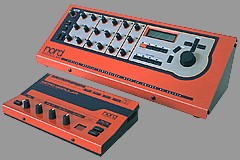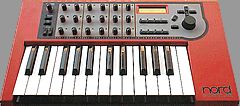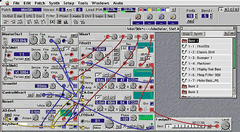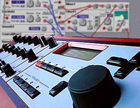| |
| INTRODUCTION |
 |
 |
Introduced
in late 1997, the Modular is something really innovative from the
point of view of programming facilities and sound research. The
basic idea comes from the original analog modular synthesizer, a
technological masterpiece that during 70's inspired the most important
artists, from Wendy Carlos to Keith Emerson. Despite his incredible
power in sound programming, the analog modular synthesizer's success
was limited by four important problems: programming time, high cost,
large size and overweight. Clavia surpassed these limits proposing
a new idea: a little sized unit that, for a reasonable cost, offers
the same programming power thanks to a virtual patching enviroment
supported by an external computer (Mac/Win platform).
 Technical
Details Technical
Details
 Nord
Modular Editor Nord
Modular Editor
 Software
Updates Software
Updates
|
| MODELS |
 |
|


|
Three
different models are currently produced: the Modular Rack, the Modular
Keys and the Micro Modular. All these models feature the same sound
quality and timbral response. The Micro can be considered as a light
version only for the look, the minimal control panel and I/O section.
The DSP power is also limited, but this affects mainly polyphony
and polytimbral capabilites, not sound quality.
|
| |
| MAIN
PLUS |
 |
 |
CONVENIENCE
- The Modular unifies the sound power of modular analog synthesis
with the digital technology advantages. For example, you can program
incredibly large virtual patches in studio using the Modular with
a computer and then move to the concert stage without any carriage
problem. The Modular weight and dimensions are minimal, but a large
number of memories can be instantly recalled offering very complex
patches without the need of physical modules and connections. Compared
with the previous versions (limited to 100 memory locations), the
Modular v.3 operating system provides 9 banks able to store up to
99 memories each (depending from the number of modules used). A
specific Patch Compression algorithm allows to optimize this kind
of memory management.
FLEXIBILITY - Thanks to his open system, the Modular can virtually
emulate the large modular systems of the past (such as Moog System
55, Roland System 700, etc.), but also redesign the block diagrams
of 70's popular synthesizers like the ARP Odissey or the MiniMoog.
More, the polyphonic features allow the Modular to play also like
a polyphonic analog synthesizer, having as reference SCI Prophet
5, Yamaha CS80, Roland Jupiter 8 and other hystorical examples.
But the programming area is not limited to analog experience. Further
types of synthesis are available, including digital FM synthesis
introduced by the Yamaha DX series. Also drum machines, step sequencers,
arpeggiators, vocoders and others items can be programmed and stored
for any possible use. The rest is limited only by the user creativity.
AUDIO QUALITY - The Modular system is based on advanced physical
modeling technology and sound so "warm" with analog patches as "clean"
using FM programming. Really exciting.
|
| |
| BASIC
OPERATION |
 |
 |
GENERAL
- The Nord Modular patches should be created with the computer (using
the Modular Editor software), but, once stored in memory the sound
structure, the Modular is able to work as a stand alone instrument.
In other words the sound is always generated by the Modular and the
computer support is required only in order to select and assemble
the required modules, not for parameter editing that can be performed
also directly from the Modular itself. And, because this is typical
of analog systems, parameter editing can be performed also in real
time thanks to the 18 assignable knobs, always available on the front
panel of the instrument. In addition to this, further parameters can
be controlled via MIDI using a master keyboard or any type of remote
controller.
|
INTERFACE
CONNECTIONS - The connection with the computer is possible thru dedicated
MIDI in/out ports, while additional MIDI in/out ports are available
for typical MIDI communication (with master keyboard, sequencers,
etc).
|
PROGRAMMING
- Once the Modular and the computer are linked, the Modular Editor
offers a graphic environment were virtual modules can be connected
togheter using virtual cables. The modules are selected using the
mouse with "drag & drop" facilities and cables can be created just
clicking on an output and dragging to the desired input. Parameter
programming can be performed by computer or directly from the Modular
rotary encoder. In any case it is important to remember that the computer
is just a controller. It can offer a powerful programming support
and library management in order to expand the available interface,
but, except for this, all the rest depends from the Modular that is
a real, stand alone, musical instrument and not a black box.
 Nord
Modular Editor Nord
Modular Editor
|
POLYTIMBRAL
CONTROL - The Modular offers also polytimbral features that can be
very useful when using with a sequencer. Up to 4 independent parts
can be simultaneously controlled on the related MIDI channels, accordingly
with the available polyphony.
|
POLYPHONY
- The Modular polyphony depends from the available DSP power. 4 DSP
are available as standard, providing up to a maximum of 32 notes (1
DSP only for the Micro - from 1 to max 4 notes) while an expansion
kit (Modular only) adds 4 additional DSP for extra-programming power.
The basic concept is simple: the more complex is the patch, the less
is the available polyphony. What is a little bit more complicated
to understand is the logic behind this concept, in order to be able
to program always knowing the real number of available notes. Anyway,
starting from Modular Editor v.2, a special window is provided that
continously monitors the available polyphony during programming.
|
| SOUND
LIBRARY MANAGEMENT - The computer support is also really useful in
order to manage and archive sound libraries that can be easily saved
and loaded using internal HD. Furthermore, thru the computer, the
Modular is also able to access to the Internet benefits, like for
example a connection with Clavia Web Site (www.clavia.com) where software
upgrades and sound libraries can be downloaded for free. |
|
|
|
 |



